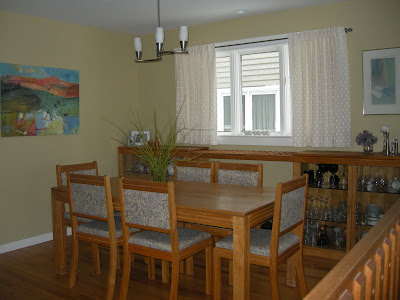Remove "clutter" and visually open the space
There isn't one "look" for a calm decor but there are guidelines/principles that can help you achieve a quieter environment in your own home.
A clutter free home is usually achieved by having a place for everything and that means adequate behind the scenes storage. Of course filling up drawers and cabinets with junk defeats the purpose! Purge to the core.
Limit palettes

If you want a calm look you have to think about colours that are soothing. It won't be red or orange! White is at the top of the list, but if that is too stark, go for other restrained colours like soft grays, ivories, soft beiges and neutrals that hint at lavender, green or blue. Consider painting walls and trim the same colour. Then add accents that are softer colours like this beautiful green.
Accent judiciously
Choose bursts of colour in smaller accessories like pillows or vases. Hang one colourful artwork or stack objects on a tray. Again less is more. Note how the light textured rug helps to soften the harder lines of the furniture.
Simplify window treatments or have bare windows
Control pattern and layer texture
You can use pattern effectively in minimal spaces, but control the scale and loudness of it. Small scale and tone on tone work best. Ramp up your use of texture to create visual interest, think quilted, knobby, woven, rough, smooth etc.
Open up the space
Spaces are restful when your eye can find a place to rest . The more open spaces the more restful. Think about unrestricted sight lines in a space. Don't block walkways or windows with furniture , leave enough space to provide ease of movement. Of course light coloured furniture helps your eye move over it. Your room doesn't have to be stark. Warm it up with light textured rugs or throws.
Choose furniture with clean lines
Forget about ornamentation and frills. Don't go for overstuffed and large scale, but do go for comfort. No decor should be uncomfortable to live in.
Use repetition
Repetition is a wonderful soother. Consider repeating the same shape or colour to move the eye along.
The repetition of colour and the shape in the white chairs moves your eye along and helps with the competition of the black chair and vessel. Natural elements are always attractive and calming especially when paired with vertical objects. I love the way the chair and flower act like an exclamation point.
Nature and repetition together creates a stunning shower.
Select uniform wood finishes
The use of similar wood tones pull this room together visually. You eye moves easily from piece to piece and the lighter colour palette is soothing and doesn't take away from the wood.
Use natural elements
Plants, twigs, stones, pebbles, water, reference the calmness of nature cycles. Use them well.
Include circular shapes
Nothing is more calming than spheres or circles. Think of several places you can add them to your decor. A round table encourages the eye to mover around a space, round mirrors are calming when well placed. People often forget that mirrors can reflect aspects of decor that are not complementary to ones focus.Open vessels/bowls are soft and flowing. Look back through the images to see how they have been used in various decors. 


























